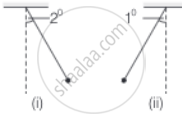Advertisements
Advertisements
Question
Consider a pair of identical pendulums, which oscillate with equal amplitude independently such that when one pendulum is at its extreme position making an angle of 2° to the right with the vertical, the other pendulum makes an angle of 1° to the left of the vertical. What is the phase difference between the pendulums?
Solution
Consider the situations shown in the diagram (i) and (ii)

Assuming the two pendulums follow the following functions of their angular displacements
`θ_1 = θ_0 sin(ωt + phi_1)` .......(i)
And `θ_2 = θ_0 sin(ωt + phi_2)` .......(ii)
As it is given amplitude and time period are equal but phases being different.
Now, for the first pendulum at any time t
`θ_1 = + θ_0` .....[Right extreme]
From equation (i), we get
⇒ `θ_0 = θ_0 sin(ωt + phi_1)` or 1 = `sin(θt + phi_1)`
⇒ `sin pi/2 = sin(ωt + phi_1)`
or `(ωt + phi_1) = pi/2` ......(iii)
Similarly, at the same instant t for pendulum second, we have `θ_2 = - θ_0/2` where θ0 = 2° is the angular amplitude of the first pendulum. For the second pendulum, the angular displacement is one degree, therefore `θ_2 = θ_0/2` and a negative sign is taken to show for being left to mean position.
From equation (ii), then `- θ_0/2 = θ_0 sin(ωt + phi_2)`
⇒ `sin(ωt + phi_2) = - 1/2`
⇒ `(ωt + phi_2) = - pi/6 or (7pi)/6`
or `(ωt + phi_2) = - pi/6 or (7pi)/6` ......(iv)
From equations (iv) and (iii), the difference in phases
`(ωt + phi_2) - (ωt + phi_2) = (7pi)/6 - pi/2`
= `(7pi - 3pi)/6`
= `(4pi)/6`
Or `(phi_2 - phi_1) = (4pi)/6 = (2pi)/3` = 120°
APPEARS IN
RELATED QUESTIONS
Answer the following questions:
A time period of a particle in SHM depends on the force constant k and mass m of the particle: `T = 2pi sqrt(m/k)` A simple pendulum executes SHM approximately. Why then is the time
Answer the following questions:
The motion of a simple pendulum is approximately simple harmonic for small angle oscillations. For larger angles of oscillation, a more involved analysis shows that T is greater than `2pisqrt(1/g)` Think of a qualitative argument to appreciate this result.
Answer the following questions:
A man with a wristwatch on his hand falls from the top of a tower. Does the watch give correct time during the free fall?
Answer the following questions:
What is the frequency of oscillation of a simple pendulum mounted in a cabin that is freely falling under gravity?
Show that, under certain conditions, simple pendulum performs the linear simple harmonic motion.
If the particle starts its motion from mean position, the phase difference between displacement and acceleration is ______.
The period of oscillation of a simple pendulum of constant length at the surface of the earth is T. Its time period inside mine will be ______.
Which of the following statements is/are true for a simple harmonic oscillator?
- Force acting is directly proportional to displacement from the mean position and opposite to it.
- Motion is periodic.
- Acceleration of the oscillator is constant.
- The velocity is periodic.
The length of a second’s pendulum on the surface of earth is 1 m. What will be the length of a second’s pendulum on the moon?
A cylindrical log of wood of height h and area of cross-section A floats in water. It is pressed and then released. Show that the log would execute S.H.M. with a time period. `T = 2πsqrt(m/(Apg))` where m is mass of the body and ρ is density of the liquid.
